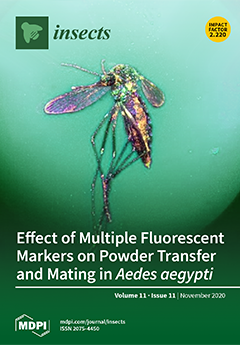The subfamily Aphrodinae (Hemiptera: Cicadellidae) contains ~33 species in Europe within four genera. Species in two genera in particular,
Aphrodes and
Anoscopus, have proved to be difficult to distinguish morphologically. Our aim was to determine the status of the putative species
Anoscopus
[...] Read more.
The subfamily Aphrodinae (Hemiptera: Cicadellidae) contains ~33 species in Europe within four genera. Species in two genera in particular,
Aphrodes and
Anoscopus, have proved to be difficult to distinguish morphologically. Our aim was to determine the status of the putative species
Anoscopus duffieldi, found only on the RSPB Nature Reserve at Dungeness, Kent, a possible rare UK endemic. DNA from samples of all seven UK
Anoscopus species (plus
Anoscopusalpinus from the Czech Republic) were sequenced using parts of the mitochondrial cytochrome oxidase I and 16S rRNA genes. Bayesian inference phylogenies were created. Specimens of each species clustered into monophyletic groups, except for
Anoscopusalbifrons,
A. duffieldi and
Anoscopuslimicola. Two
A. albifrons specimens grouped with
A. duffieldi repeatedly with strong support, and the remaining
A. albifrons clustered within
A. limicola. Genetic distances suggest that
A. albifrons and
A. limicola are a single interbreeding population (0% divergence), while
A. albifrons and
A. duffieldi diverged by only 0.28%. Shared haplotypes between
A. albifrons,
A. limicola and
A. duffieldi strongly suggest interbreeding, although misidentification may also explain these topologies. However, all
A. duffieldi clustered together in the trees. A conservative approach might be to treat
A. duffieldi, until other evidence is forthcoming, as a possible endemic subspecies.
Full article






